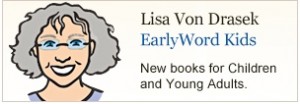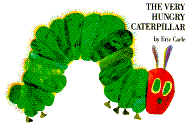Evaluating the Cost of Picture Books
After my rebuttal on the merits of picture books, I received this comment from a famous best-selling author by email,
Our publisher pals need to re-think ….the high prices they are charging…$18 for a book when you are struggling to keep/find a job is impossible.
The esteemed young adult author, Marc Aronson stated recently on CCBC_Net listserv (available only to subscribers), that these “books are so slim they disappear, a parent faces a relatively high cost (say $16) for a relatively short immersion experience (32, 40, 48 pages plus the effort the parent puts into engaging the child spread by spread).”
WHAT?!!!!!
Rounding up, let’s say a hardcover picture book is twenty dollars. Let’s consider The Very Hungry Caterpillar. In many households, it is read every night for four months, or 120 hours. This experience is seventeen cents a reading.
“Plus the effort the parent puts in engaging the child spread by spread.” Is Marc Aronson looking for a fight? That “effort” is bonding with a young child, that “effort” is building early literacy skills, that “effort” will pay off in untold dividends in a stronger vocabulary, ability to track cause and effect, and create the beginning of the understanding that one can derive enormous enjoyment from the words on a page. Let’s add to this – shared meaning and fun.
A child who is having a whiny moment can be reminded of Llama, llama Red Pajama. A child inappropriately seeking attention can be distracted with a story on a bus or a train. Whether in hard copy, on a Nook or an iPad, a picture book can save a restaurant meal from a too hungry, too tired child meltdown.
Need a study?
“Children’s Access to Print Material and Education-Related Outcomes,” says that not having access to print materials (i.e., books) in the home is detrimental to a child’s ability to succeed in the elementary school years.
Want to talk money?
Let’s compare to other monetary wants of childhood…
- The DVD of a new movie, $30.
- New cool electronic hamsters, $15 dollars a piece, collect them all! Accessories, $20 a set.
- A dancing Micky Mouse $93
- PlayScool Alphie, $45.
- Can a parent leave a movie theater or museum less than $40 lighter in the wallet?
- One dinner at McDonalds for a family of four?
Where is your $16 to $18 going? We can agree that the artist and the writer should get paid. How about the art director who created the object? The editor who discovered, nurtured the writer and championed the book? The publisher who produced the books, balanced the books, and kept things on schedule? The marketing people who had to shine a light on THIS book in a crowded market, let librarians, booksellers, and parents know about this fabulous new illustrator?
Mr. Aronson also suggests some ways to get books in the hands of parents and children for less money (for instance, creating subscription plans). Let’s not reinvent the wheel. There is a way. Paperback. The top selling paperback picture books on Amazon are $6.00 and $7.00. Scholastic Book Clubs distribute through classrooms and sell paperbacks at affordable prices. REading is Fundamental gives books away (www.rif.org).
Is there a place where a parent can go for expert advice on picture books for their child? A community center where professionals have selected the best of what is available and share this knowledge freely with anyone who walks through the door? A place where parents can borrow books read to their children?
Oh, right — THE LIBRARY.
How much will borrowing a pile of picture books cost? Nothing, nada (admittedly, that’s not really true. Tax dollars paid for them and for that expert). If the books for children in your local library are ratty and old, use your voice to demand a children’s librarian who is knowledgeable, to raise funds for new books.
Going without picture books is not an option. The loss to a child of not sitting with a parent or older sibling, turning those thirty-two pages, poring over the art, repeating joyfully those juicy words, cannot be replaced.
A week of Starbucks’ Lattes — $24.50
The cost of a Michael Jordan sneaker? — Seriously.
Snuggling with a five-year-old, laughing over John Scieszka’s Truckery Rhymes?
Priceless.



November 5th, 2010 at 4:02 pm
Oh my gosh, I can’t believe he actually said that. Does he not have children? My two sons, while avid TV watchers, would turn off the TV and listen to me read aloud anytime I asked–and currently at 12 and 10 years old they would still do this! Why would they do it even now–because of all the time we spent reading together when they were little. The bonding time was invaluable!!
November 5th, 2010 at 5:17 pm
Bravo! My sentiments exactly!
November 5th, 2010 at 5:35 pm
Lisa, I definitely agree with your argument about the importance of books! :) But I’m not sure Marc was presenting the ideology that you are debating.
I believe Marc was saying that paperback picture books are so slim they literally disappear on the shelves, which means that in order for folks to physically see new picture books, they need to be released in hardback (at least, in current display arrangements)? Not that picture books are too slim to have substance.
I also think that Marc was talking about what a given parent *may* be thinking when they go into a bookstore, in these tight economic times – not what they *should* be thinking, or what books are worth in a broader sense. For that, I can tell you that he is right in at least some cases, from conversations I have had with other adults.
About the package deals, it seemed he was suggesting that training a non-book-oriented parent into the book experience might be done by creative interplay between books? If I did read that aright… well, there are folks like you and me (and Marc, for that matter) for whom books are staples. You don’t have to convince us that we should, or show us how to, incorporate books into our lives. But the Little Golden books and similar series were accessible to the non-book-crazy, and that is a gap group we should consider, and to which I think his package idea was proposed?
And finally, about effort. For many of us, reading with our children is a joy. But when parents are overworked and stressed, if reading is not already part of their routine, or if they are asked to read and reread books that do not resonate with them, or if their child is squirrely and won’t listen… yeah, I can see how that would be an effort. (If I had to read most of the stuff I see featured in mainstream bookstores, trust me, it would take a major effort to stay sane.)
So, again, I agree with your base premise. It’s just my sense that from what he has said, Marc does too. :)
Cheers!
Maia
November 5th, 2010 at 5:56 pm
I love your list of expenses and of course I agree that buying picture books is an excellent thing for all concerned. I’m not sure you summarized Marc Aronson’s views entirely fairly though. For instance, his comment on the books being slim referred to how skinny paperback picture books are.
November 5th, 2010 at 6:09 pm
I would like a share button so I could just click to be able to share on my facebook page.
I will copy the link and put it there anyway.
November 5th, 2010 at 6:22 pm
While I totally agree with your statements regarding the need for picture books in children’s lives I also think the economic argument is something that needs to be thought about. If we aren’t simply thinking about the middle to upper class portions of society we are faced with a heartbreaking reality that many parents CANNOT afford a twenty dollar book. As a teacher I spend my life working with students who cannot afford lunch, shelter, their uniforms, nonetheless books. I know there are other ways of accessing these books, but as a general commodity that is so central to the development of student literacy 20$ children’s books play into the ever increasing divide in student ability based on students’ economic situations. There must be ways to make these books more affordable and accessible to all of our children.
November 5th, 2010 at 8:27 pm
Thanks for this post. You state the case quite well.
How about, just for example, can we have a show of hands of those parents who can recite Goodnight Moon?
November 6th, 2010 at 1:33 pm
I’m not sure that the economic argument “against” picture books is the only one, or even the main one. Maybe it’s the communities in which I work, but I find more and more parents who want to push their children into reading “harder” books. We even had someone come into the library looking for chapter books for her three-year-old. Though that may be an extreme case, many parents of older children will say “no” because “that book is too easy,” not realizing that even the “easy” books promote literacy by 1. making reading enjoyable with a book the kid actually picked out for herself and 2. firming the foundation and confidence of a child who’s already a fair/decent/good/excellent reader.
November 6th, 2010 at 5:01 pm
I agree with others that you may be misstating Marc’s point a bit. But I also think you’ve left out a key element. Yes, books like The Very Hungry Caterpillar may get read over and over again to a child, providing hours of entertainment for a reasonable price. But a parent might just as easily spend the $20 on a book that their child has no interest in whatsoever. Perhaps they’ll sit through one read if you’re lucky, but still you’ve just spent that $20.
Yes, librarians and other knowledgeable advisors can steer a parent towards more likely contenders, but even in those cases the book may not appeal to your child. There are probably some kids out there in the world who won’t like that Caterpillar (though I find it hard to believe!) and thus each purchase becomes a riskier proposition for a parent.
Yay for libraries in that they do provide the needed source of books to try with your kids. And yay for all those children’s librarians who purchase them and advise parents on which ones to check out. But as regards the initial article it could simply be that people are being more cautious with their discretionary spending and just aren’t buying the books.
November 6th, 2010 at 5:49 pm
A few of the commenters have noted that I may have misread Marc Aronson’s remarks and had not reported them accurately. That is possible. Marc has written that this was NOT his point-of-view that he was reporting out what some parents may be experiencing when faced with a $16.00 picture book purchase. That we are actually on the same page as to the value of picture books in the lives of young children. I stand corrected.
I also stand by my responses that picture books are not too expensive. Yes, it is possible that you will choose the wrong book for a child, that is why there are children’s librarians, American Library Association notable book lists, websites like the CCBC, http://www.education.wisc.edu/ccbc/books/bibBio.asp, recommended booklists like the Best Books of the Year from the Children’s Book Committee at Bank Street for recommended reading. http://www.bankstreet.edu/bookcom/
November 6th, 2010 at 11:52 pm
Just FYI, RIF books are no longer free; the school has to “subscribe” to the service in order to get a distribution. At my school of 220 students it is over $1,000, which the PTO is struggling to come up with.
November 7th, 2010 at 9:19 am
LeeLee,
I appreciate that your school is struggling to provide RIF books free to students to take home and keep for their own. RIF itself is struggling with funding cuts. When I worked at the Brooklyn Pubic Library, the Wed. Afternoon RIF distribution was one of the most joyous parts of the job. The books were not free to the library but were free to the kids. Here is a question….why do people expect books to be free? Seriously, food isn’t free, electricity isn’t free, telephone service, heat, Internet access, cable tv….
November 7th, 2010 at 9:34 am
I don’t think you can really argue with the fact of picture books (or anything, really) being “too expensive.” If I feel like I can’t afford something, it’s too expensive. More pertinent to the point is that *publishers* are finding picture books too expensive: printing costs are high, as is (as Marc notes) consumer resistance. This is why we are seeing so much razzle-dazzle–celebrity authors, sequels and spinoffs to successful books, board book knockoffs. Although I am dubious about the crucial please-read-it-again factor of most of the just announced NYTBR Best Illustrated choices, I applaud the fact that the judges went low-key and sequel-free!
November 8th, 2010 at 7:20 am
Roger,
Of course I agree with you…I would love to have an Eileen Fisher wool coat but at $400 it is too expensive for me but once or twice a year, I can afford a sweater or jacket from the outlet store. ‘*publishers* are finding picture books too expensive.” I will have to think about that…as I look at the piles and piles of picture books submitted for review…
I personally have nothing against those sequels if the 4th Llama, llama book supports the new unknown writers and illustrators.
Not sure what you mean by this ” Although I am dubious about the crucial please-read-it-again factor of most of the just announced NYTBR Best Illustrated choices”
Could you elaborate?
November 8th, 2010 at 1:49 pm
I think you are protesting a bit too much here. The sad fact is that hardcover picture books do cost too much money for most folks. Which is why we should all be grateful that the public library provides them for us.
I don’t know about you but…we go through 10 or more a week around our house. It’s nice to be able to hop over to the library and re-load at a moments notice.
Not sure what the point of the price breakdown of things. We all know how much things cost. And libraries will always reduce their chidlren’s budget last.
No worries, just get yourself to the library.
November 9th, 2010 at 9:35 am
[…] discussion about the price of picture books rages on. In response to my defense of current prices on a cost-per-use basis, one person replied, Yes, books like The Very Hungry Caterpillar may get read over and over again […]
November 9th, 2010 at 11:05 am
Lisa–while I think all the NYTBR choices are beautiful, I also find them (as a group) emblematic of one of the big picture book problems in today’s market: excepting Golly and Bink (which is more of a reader than a picture book, I think) none of them are going to have kids begging for a re-read (IMO). And nobody wants to buy a picture book that is only going to be read once.
November 9th, 2010 at 1:20 pm
[…] Consider some of the other ways we spend our money on our kids, like Lisa Von Drasek does on this post at EarlyWord, and see if a picture book somehow doesn’t feel as expensive […]
November 22nd, 2010 at 12:11 pm
I’d much rather pay $18 for a picture book that feed four mouths at McDonalds. Too-shay!